Health Benefits of Sea Buckthorn Oil
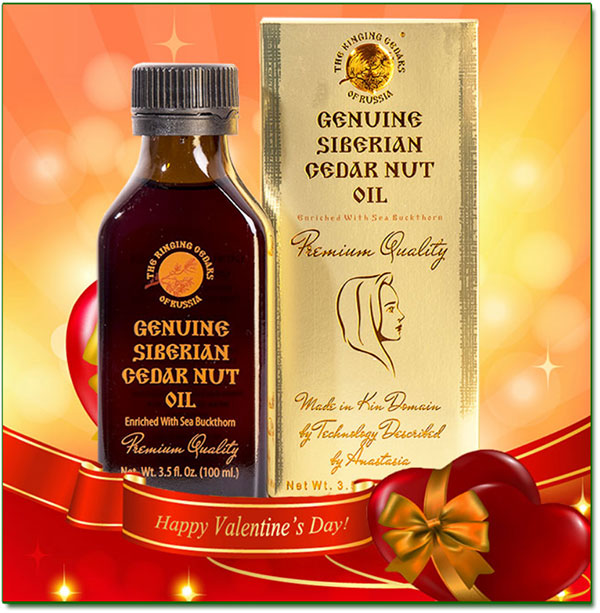
Sea buckthorn oil, which has been known to heal even the most serious wounds, has always had a special importance. This oil was made by hand: the dried berries were covered with vegetable oil in a pot, and placed into a Russian stove for the night.
How it is obtained
Nowadays, for the production of sea buckthorn oil, an inexpensive and not very high quality vegetable oil or, in the best case, a low-grade olive, almond, or sunflower oil is most often used as an additional ingredient. Strictly speaking, the finished product does not contain a great deal of sea buckthorn oil (20 carotinoids), since it is, in fact, an infusion of vegetable oil with sea buckthorn berries of a bright orange colour.
The Ringing Cedars of Russia company uses only cedar nut oil and only that of the highest quality and only wild harvested Siberian sea buckthorn berries to create a sea buckthorn extract. Thanks to a special technology, the Ringing Cedars of Russia company's sea buckthorn oil contains 100 carotinoids, which is obvious from the oil's deep dark orange colour, rich sea buckthorn taste, and fragrance.
Thanks to these two facts, sea buckthorn oil from the Ringing Cedars of Russia company is greatly superior in its medicinal qualities to the sea buckthorn oil of other producers.
Properties
- It strengthens the immune system.
- Sea buckthorn oil possesses wonderful wound-healing action. It is used internally to treat peptic ulcers of the stomach and duodenum.
- It possesses high biological activity.
- It possesses bactericidal properties, therefore it is good to use sea buckthorn oil in suppurating wounds that take a long time to heal, and in any skin problems.
- It has analgesic properties.
- It increases the elasticity of the blood vessels, and improves blood circulation.
- It lowers the level of cholesterol in the blood.
- It has an antimicrobial action. It is wonderful for treating all types of stomatitis, periodontosis, and tonsillitis.
- The oil is wonderful to apply for treating the hair. The use of sea buckthorn oil accelerates hair growth. The application of sea buckthorn oil is also recommended for the elimination of dandruff.
- Sea buckthorn oil is very useful for improving cardiac activity.
- Sea buckthorn oil has laxative properties, and so it is prescribed for the treatment of constipation.
- It prevents the development of obesity.
- It normalizes metabolic processes in the body.
- It hinders the development of thrombosis.
- It normalizes and restores the operation of the liver.
- It improves vision.
- It possesses general stengthening action.
- It is useful for men in preserving their virility.
- It improves the functioning of the pancreas and the thyroid gland.
- It protects the skin from the harmful effect of ultraviolet light.
- It is effective in cosmetology for the elimination of freckles and pigmented marks, and smooths out wrinkles.
|
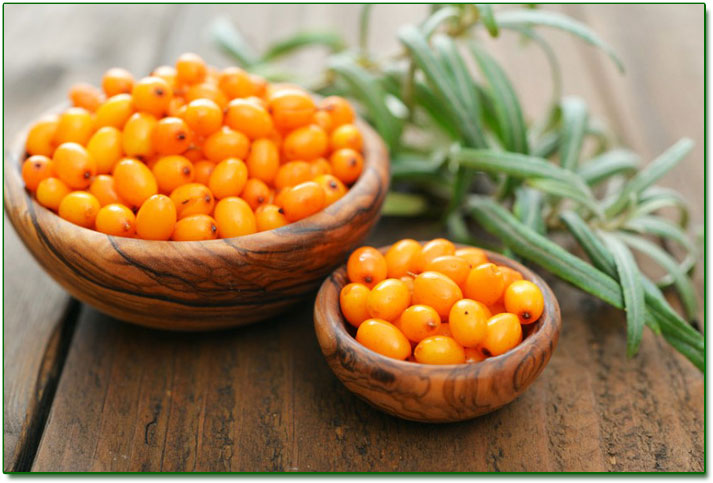
Sea buckthorn oil - Treatment and Application
Internally, sea buckthorn oil is used for the treatment of diseases of the stomach and duodenum, for the treatment and preventive treatment of atherosclerosis, in metabolic disorders, to level out the hormonal background, for the comprehensive treatment of infertility, in stomatitis, and several other problems and illnesses.
Externally, sea buckthorn oil is used to heal wounds and burns, for the preventive treatment of premature aging of the skin, to fortify the hair, and to sharpen vision.
Now about this all in more detail.
Sea buckthorn oil in gastritis, and ulcers of the stomach and duodenum
This is perhaps the most widespread manner of using sea buckthorn oil. The recommendation is to take 1 teaspoon of the oil 3 times per day a half-hour before eating. In the morning, it is essential to take it on an empty stomach. At the very beginning of the treatment, unpleasant sensations may occur. These include a bitter taste in the mouth and heartburn. This stage must simply be tolerated; everything must be taken according to the schedule. The course of treatment is 1 month.
Sea buckthorn oil in stomatitis
Those areas requiring treatment may simply be rubbed with the oil. But, in our experience, it is best to apply a compress to the problem areas. Simply take cotton or sterile gauze, soak it in the oil, and apply it. It should be held for at least 5 to 10 minutes. Afterwards, do not eat or drink for a half-hour to an hour.
Sea buckthorn oil for the nose. Treatment of a head cold
Place 2 to 3 drops of sea buckthorn oil in your nose 3 times per day. The nasal passages may also be moistened with sea buckthorn.
Sea buckthorn oil in tonsillitis
Rinse the throat with the following solution: dissolve 1 teaspoon of oil in 0.5 litres of warm water. Rinse every half-hour. This emulsion is also very good for making compresses for the throat.
Sea buckthorn oil in radiation injuries
Take 1 teaspoon 3 times per day internally. Also beneficial are the berries themselves, both fresh and frozen; a tea can be made from sea buckthorn shoots and leaves.
Sea buckthorn oil in atherosclerosis
For preventive treatment, it is best to take the oil twice per day, 1 teaspoon a half-hour before eating. The course of treatment is 1 month.
Sea buckthorn oil in diseases of the upper respiratory tract
It is best to carry out a course of inhalations of sea buckthorn oil—10 procedures consisting of 15 minutes daily.
Sea buckthorn oil in gynecology: tampons with sea buckthorn oil
These tampons are used for the treatment of cervical erosion. Liberally soak a tampon (using approximately 5–10 ml of oil); press the tampon tightly to the area of the erosion, and leave it for 12 hours. Change the tampons daily. The procedures are carried out as a course of treatment consisting of 8 to 12 procedures.
Sea buckthorn oil in burns, for the treatment of wounds that are difficult to heal, for the treatment of bedsores and frostbite
It is best at the very beginning to dress the wounds with a solution of furacilin or penicilin. Then apply a bandage with sea buckthorn oil. Change the bandage daily. This treatment gives very good results.
Sea buckthorn oil in hemorrhoids
It is best to combine an internal dose of the oil with an external application in the form of compresses. Place gauze soaked in sea buckthorn oil on the painful area. It may be applied for a short time (an hour), or may be left for the entire night. If there is no possibility of applying a compress, then the painful areas may be lubricated simply by using a cotton swab.
by Olga Andreeva, PhD.
Copyright: RingingCedarsofRussia.org
Image copyright: TS/Fotobank.ru
Customer Reviews:
I use your sea buckthorn oil on my face — it is simply wonderful! I apply sea buckthorn oil once a week on my entire face and neck, I leave it for 15 to 20 minutes, wash it off with warm water without any soap or gel, and then apply cream to my face. I have felt the moistening effect, my skin becomes smooth, and my freckles have practically disappeared. I have done a mask only twice, but I began to received five times as many compliments from my husband. My skin is like the skin in the glossy magazines.
Thank you very much!
Vera Soboleva, Moscow, Russia
* * *
I suffered from periodontosis for a long time. I was being treated by a dentist. They used electromassage, ointments, rinses. The treatment proceeded slowly. My teeth were exposed, my gums were inflamed. The dentist advised me to used sea buckthorn oil. I'll describe the method of treatment; perhaps it will be useful for someone. Initially I rinse my mouth, brush my teeth, then rinse my mouth with an extract of oak bark. After this, I make a type of wick from cotton, moisten it with sea buckthorn oil, and place it on my gums. I keep it there as long as possible, until no oil remains on the wick. At the same time, I use it to moisten my throat. The improvement was immediately noticeable: previously my throat would burn, but my throat has stopped hurting, and my gums have returned to normal.
G. V. Nechaeva, Pskov, Russia
* * *
Several years ago, I had an accident—I scalded my leg with boiling water. Blisters appeared, and my leg turned black. My neighbor advised me to apply sea buckthorn oil to the place of the burn, and within several minutes the pain went away, and by the end of the day, the blisters had subsided...
Marina Yurkova, Moscow, Russia
* * *
In the spring of 2012, I went to an optician complaining that my vision was deteriorating. The diagnosis was a cataract. The only thing to do was operate. But I had read somewhere about sea buckthorn oil. I began to apply two drops of the oil in both eyes almost every day. It stung and burned, but I put up with it. I did this procedure for eight months, and did not take any other medicine. Soon, according to the second opinion of that same doctor, an operation was no longer required.
M. M. Churakov, Saratov, Russia
Buy combo "Buy 3 get 1 FREE" for cedar nut oil enriched with Sea Bucktorn for $137.40:

SIBERIAN CEDAR SEED REPRODUCTION
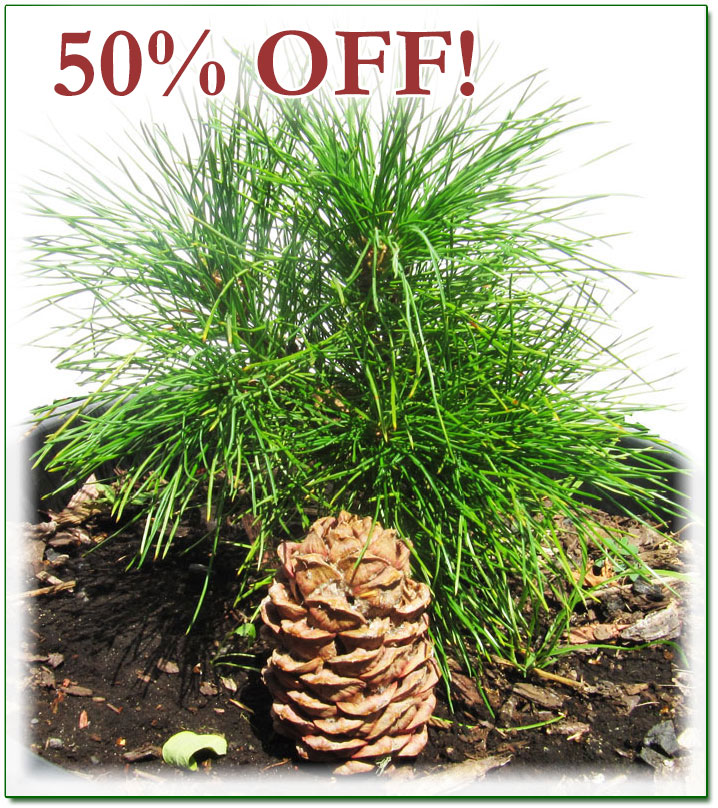
The cedar pine reproduces by seeds. The germinating capacity of seeds is preserved for up to four years. After sowing, the seeds are loosely covered with soil. The seeds germinate in the year they are sown or in the following year, more rarely in the third year, after germination the young shoots must be kept in the shade and watered, in the second year the seedlings develop only the top shoot, in the third year they form the first whorl of lateral shoots. The young plant acquires a crown usually by the time it is 5 to 7 years old, and by 15 to 25 years of age is covered with branches almost to the ground. At 20 to 30 years of age, the lower branches begin to die off, and the crown acquires an oval shape.
The seeds of the cedar pines are prepared from the middle of August-beginning of September until the middle of November. In the case of a delay in the ripening of the cones, they are collected in the spring. In order to grow the seedlings, it is recommended to sow seeds that have been stratified in the spring. In the case of further transportation of the seeds, it is important not to allow them to dry out (moisture content of less than 8-10%) or heat spontaneously, which occurs when the moisture content is greater than 20% and they are stored at a raised temperature. Seeds with an underdeveloped germ must not be extracted from the cones for two or three months before they ripen. The seeds of the Siberian and European cedar are stratified at a temperature from-4 to +3C over three to five months. The stratification of the seeds can take place in an ice box, a deep trench, cold basement, in boxes under the snow, and in cold rooms. The seeds are mixed with two to three times their volume of sterile substratum (sand, sawdust, peat, moss). When placing them for stratification, the seeds should have a moisture content of 20 to 40%, while the substratum should have the least (field) moisture capacity. In all methods of stratification, it is necessary to provide good drainage and protection from rodents.
To create a supply of viable cedar pine seeds, methods of long-term storage (up to 2.5 years) in deep trenches (2.5 metres) may be used. In the latter, a constantly lowered temperature and moisture content is provided. In order to hasten the appearance of shoots and reduce losses from rodents, in the spring planting it is expedient to use seeds that have begun to sprout slightly. For one linear metre 120 to 140 seeds are placed at a depth of three to four centimetres. Protection of the shoots from birds is ensured by covering the surface of the soil with a layer of sawdust (3-4 cm). The technology of growing the cedar seedlings is no different from that used for other conifers (shade, watering, protection from flattening, cultivating the soil, weeding).
Planting Evergreen Progeny
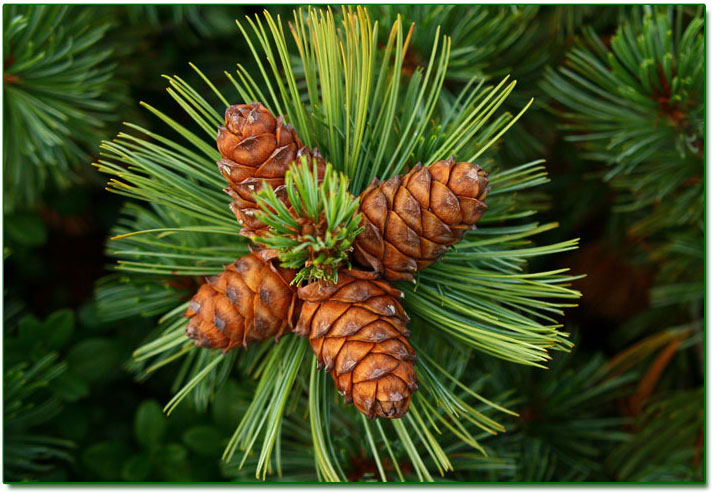
Stands of cedar pines are created by planting on partially worked soil (furrows, beds, terraces) in the spring, autumn, and in the second half of the summer (in areas with increased humidity in July and August). When growing forest stands of cedar, attention should be directed to the creation of solid, pure stands of cedar in conditions of fresh and moist coniferous forests growing in relatively rich soils, or more rarely in mixed pine forests growing in sandy soils.
Even though they are very tolerant of shade in their first years, cedar pines nevertheless give the best growth performance in conditions of sufficient illumination. The competition of grass has a great influence on the intensity of the growth and the preservation of cedar stands. The experience of producing a cedar in various forest-growing conditions of Central Siberia has convincingly shown that the intensification of its growth and high preservation may be achieved only by caring for it over the course of seven to nine years. In optimal growth conditions and with intensive agricultural technology, already at 15 years of age Siberian cedar plants reach a height of 3.5 to 5 m. The beauty and severity of the majority of coniferous trees cannot leave anyone indifferent - they very much coincide in mood with the image of our northern landscape! In order to grow coniferous trees successfully in a cultivated plot (or outside its fence), several obligatory rules must be remembered.
Thus, the planting of coniferous species in the same group with deciduous trees, or their combination in a single hedge cannot be permitted. Coniferous trees do not tolerate contact with the branches and leaves of their deciduous fellows, which, as is said, "whip" them (that is, remove the needles). After this type of "interaction," the tops and a part of the crown of coniferous trees dry out and are rarely able to recover their previous form and beauty. In addition, hedges and groups made up of only conifers are more decorative. The planting and transplanting of coniferous species is permissible only when the ball of earth around the roots is preserved. Only very young saplings (2 to 4 years old) taken from a nursery may be planted in the early spring without this ball, as long as the roots are not permitted to dry out. If you are growing conifer seedlings in your beds (this is entirely possible), then it is expeditious to do it in soils that cling well to the roots of saplings that are dug up. But it is also possible to grow coniferous seedlings in special baskets, boxes, or jars buried in the soil. These seedlings are ready for transplanting to their permanent place of residence at any time of the year.
When transplanting evergreen seedlings from a forest, it is necessary to remember yet another rule: do not take saplings that are growing in a shaded part of the forest - they will die from the sun's burning heat and the dryness of the air, and in the best case, having lost their decorative shape, will be recovering from this malaise for many long years. It is best to direct one's choice to saplings that are growing in open, sunny clearings or at the edge of a forest.
Saplings must be transported to their parcel of land with the ball of earth on their roots wrapped in sacking. And remember: in the first year after planting and transplanting, all coniferous trees and bushes require abundant and frequent watering! A cedar should be transplanted in early spring or preferably in the fall, it is desirable to plant a cedar with a "nanny," which shields the cedar sapling from light (it can be a birch or spruce, but in 15 years it will be necessary to cut down the nanny). For transplanting, it is necessary to dig a 50x50 hole, fill it with a mixture of humus, peat, and fallen needles. If the ground is clayey, then add 1/3 sand to the hole. When transplanting it is necessary to ensure that the root system is kept intact. In the hole, the roots are spread out, soil is poured in, packed down, the root neck should be level with the soil. After planting, the plant is watered, and in the first two to three months, it is necessary to ensure that the soil does not dry out. In conclusion, I would like to quote an extract from Vladimir Megre's book The Space of Love:
"Let each inhabitant of a large city take a tiny nut from a resinous cedar cone, hold it in his mouth, bathe it in his saliva, plant it at home in earth in a small pot, and water the earth each day. Before watering, let him dip his fingers into the water, his mood should be good, and let him wish himself, and, most importantly, his descendants, his children, good and the consciousness of God. And do this every day. When the shoot emerges, he can mentally converse with it about what is secret. On a summer, frostless day, at night, the pot with the small shoot should be placed outside among other plants. Let it begin to communicate with the stars, moon, and sun, let it know the rain, the breeze, and the spirit of the grass growing nearby, and it will come back inside again to its friends, its parents. This should be done on many occasions, when you have the desire and the time. This shoot is growing for the ages, after all, a cedar will live for more than five hundred years, it will give descendants, and tell new cedars about the spirits of those who grew them. When it has grown to thirty centimetres inside, in the early spring the shoot may be planted in the earth. Let the municipal authorities allot at least one square metre to all those who do not own land. And the shoots will be planted from the edge of the city to the riverbank and along the roads, among the houses and in the centre of crowded squares, let the people each look after their shoot, and let them help each other. From all corners of the earth people will come to this city for centuries to look, to touch these sacred objects, to exchange even a word with its happy people."
Seed Output of Cedar Pines
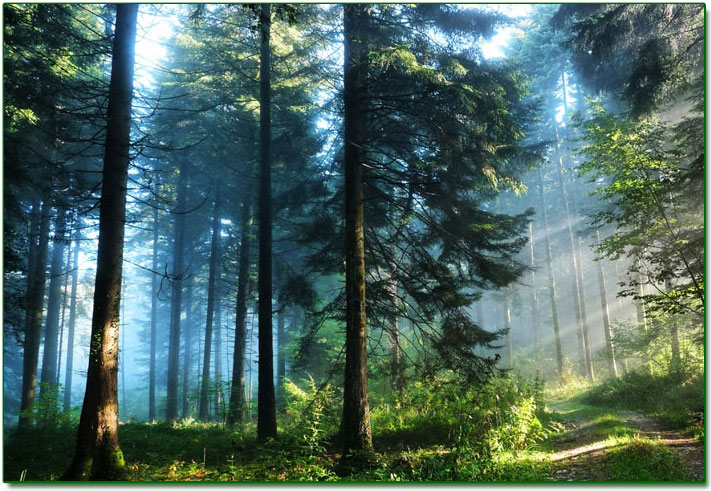
The germs of the micro- and macrostrobila in the Siberian cedar are laid down in July and August, flowering and pollination take place in June or July of the following year, and continue for 3 to 7 days, fertilization of the seed-buds occurs a year after their pollination, then over a period of 50 to 60 days the formation of the seeds is completed. The selection of the optimal period for the procurement of cedar seeds has great significance for ensuring a high productivity of work and the reduction of the damage to the trees when using existing methods of collecting the cones. Characteristic of cedar pines is an unevenness in the harvests of their cones and seeds over the years, especially in extreme growth conditions. The size of the seed harvest depends on the weather conditions in the pollination and fertilization period, and is also related to solar activity. Highly productive trees in cedar orchards yield from 40 to 100 kg in a year, while in natural stands the yield is only from 8 to 20 kg. The thinning out and pruning of cedar saplings has made it possible to advance the stage of lengthy seed-bearing in cedar forests by 50 to 120 years in relation to natural plantations.
The Air in Cedar Stands
In cedar stands the air is pure and wholesome. The antimicrobial properties of cedar forests are high. The health-improving properties of cedar stands has been pointed out by I. Ya. Slovtsev, an expert on Siberian forests. He wrote that "cedar forests always have an aromatic freshness." V. Gomilevskiy cites some interesting data in his work. When characterizing the Siberian cedar as a valuable tree, the author notes that this type of plant acts in a way to frighten off harmful insects. In particular, he writes, "Gadflies, horse-flies, mosquitoes, gnats, and insects called by the common name of "midges" avoid the Siberian cedar, in all probability, driven away by the resinous odor, which is especially strong during intense heat and after dusk." Cedar stands, thanks to the emission of bactericides, fungicides, and protozoacides, make the air more healthy and destroy pathogenic microorganisms, and impart wholesome properties to the air. They possess antimicrobial effects with respect to diphtheria bacteria. The quantity of microbes in the air decreases with an increase in the proportion of Siberian cedar in the composition of the stands. In addition, if a pine forest has an unfavourable effect on certain cardiac patients, in cedar stands "even with a very large saturation of the vapours of cedar essential oil, no negative deviations or indications of the ionization of the air are observed" (Sverchkov, 1964, p. 18). All this confirms the sanitary-hygienic and even preventive medical importance of cedar stands. Taking all this into account, it is necessary to plant more Siberian cedars in our suburban forests, in resort areas, in urban squares, gardens, and parks, especially because the Siberian cedar is more tolerant (in comparison to other conifers) of smoke and gases in urban conditions. On a hot day it provides good protection for a person from the intense summer heat. The most important biological feature, which also has great practical significance, is the great hardiness of the Siberian cedar in winter. This is one of the representatives of the nut-bearing plants that is not afraid of harsh winters and extends far to the north. Among the coniferous species, the Siberian cedar is the most smoke resistant tree, and can propagate in large industrial cities.
The Cedar and Our Ancestors
The cedar (Greek: kedros; Latin: cednis), owing to its harmonious proportions, similar to a cypress, was considered a valuable coniferous tree of the Mediterranean area, and already at the dawn of Egyptian history was brought from Lebanon to the country on the Nile, a country barren of trees. The wood of the cedar was also valued because of its fragrant resin, and was used in Egypt for the construction of ships, and the manufacture of furniture, coffins for mummies, and utensils. King Solomon used it in the construction of the temple in Jerusalem. In a Psalm (92:12) it is written: "The righteous shall flourish like the palm tree: he shall grow like a cedar in Lebanon." Origen (185-254), a father of the Church, characterized the moral and symbolic side of the concept of longevity in the following manner: "The cedar does not decay. The foundations of our homes, foundations made from cedar wood, preserve our souls from decay." Bishop Kirill Aleksandriyskiy (412-444) compared cedar wood with the body of Christ, which remains imperishable. Only the wrath of God is stronger than the cedar: "The voice of the Lord breaketh the cedars; yea, the Lord breaketh the cedars of Lebanon." (Psalms 29:5). V. Kh. von Khokhberg (1675) moreover emphasized the characteristics of the longevity of the cedar: "Solomon's temple was built of cedars. For the reason that this wood stands for many years without being destroyed or eaten by worms. When the Lord comes to bless His possessions, He will not be met with misfortune or loss." The cedar is the heraldic symbol of Lebanon, although, unfortunately, it has now been almost completely exterminated there.
In Christianity, the cedar, especially the cedar of Lebanon, is a symbol of Christ: "...his countenance is as Lebanon, excellent as the cedars" (Song of Solomon 5:15). The majestic appearance of the cedar began to be identified with the concept of beauty and grandeur. The Prophet Ezekiel used the cedar as a symbol of the Messiah and His Kingdom: "...I will also take of the highest branch of the high cedar, and will set it; I will crop off from the top of his young twigs a tender one, and will plant it upon an high mountain and eminent:" (Ezekiel 17:22).
Clay tablets of the Sumerians, found during archeological excavations of the ancient Sumerian kingdom, confirm that, 5000 years before the modern era, extracts and broths of needles were used in the form of compresses and poultices. But cedar resin was also no less valued in prehistoric times. A cup of cedar resin was a part of the ritual of the consecration of King Khorassan. The flame of Zoroaster was born from burning resin in a cup. Among the druids a cup of cedar resin was called "the cup of life."
Yarinka.ru, 2008
Buy Cedar Cone with 50% OFF for $9.50


WILD RICE SALAD WITH MUSHROOMS, CELERY ROOT, AND CEDAR NUTS
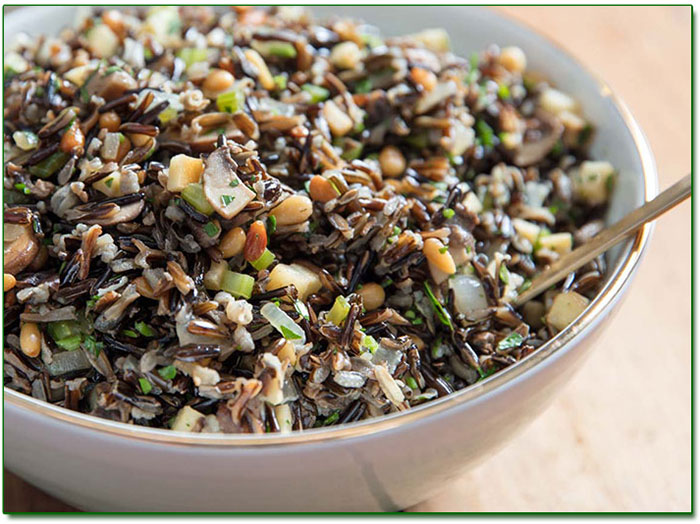
Ingredients:
- 14 ounces wild rice (about 2 1/3 cups; 396g)
- vegetable stock, or water, for cooking the rice
- salt and freshly ground black pepper
- 1/4 cup (60ml) cedar nut oil
- 10 ounces (280g) cremini mushrooms, thinly sliced
- 1 ounce (30g) dried mushrooms, such as porcini, soaked in boiling water, then drained, squeezed, and chopped (optional)
- 4 sprigs thyme
- One 12-ounce (340g) medium celery root, peeled and cut into 1/4-inch dice (about 1 1/3 cups diced)
- One 8-ounce (225g) yellow onion, cut into 1/4-inch dice
- Two 2-ounce (55g) ribs celery, diced
- 3 ounces (85g) cedar nuts, toasted
- 2 tablespoons minced flat-leaf parsley leaves and tender stems
- 2 tablespoons minced chives
- 1/4 cup (60ml) apple cider vinegar, or to taste
Preparation:
In a large pot, combine wild rice with enough stock and/or water to cover by at least 2 inches. Season lightly with salt. Bring to a simmer, then continue to cook at a simmer until rice grows tender and many of the grains have ruptured, about 50 minutes; add more water at any point as needed to keep the rice covered.
Meanwhile, in a large skillet, heat oil over high heat until shimmering. Add fresh and soaked dried mushrooms (if using) and thyme sprigs and cook, stirring, until mushrooms are golden, about 6 minutes. Season with salt and pepper.
Lower heat to medium and add celery root, onion, and celery, and continue cooking, stirring frequently and scraping the bottom of the skillet, until vegetables are just tender, about 5 minutes. Season with salt and pepper. Discard thyme sprigs.
Using a fine-mesh strainer, drain wild rice well. Transfer to a large bowl and mix with the mushrooms and vegetables. Stir in cedar nuts, parsley, and chives. Add the vinegar 1 tablespoon at a time until the salad has a subtle brightness, but not an obvious tang. Season once more with salt and pepper, if needed, then serve warm or at room temperature.
Serves 6 to 10 as a side
ROASTED CAULIFLOWER STEAKS WITH GOLDEN RAISINS AND CEDAR NUTS
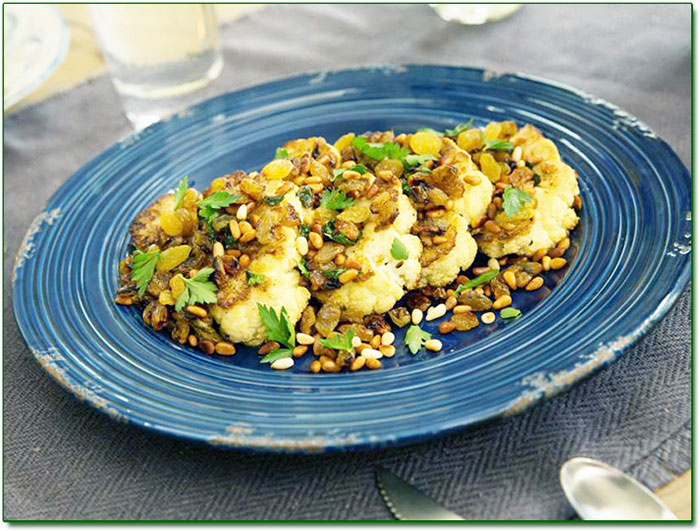
Ingredients:
- 2 heads cauliflower, cut vertically into 1/2-inch-thick steaks (4 to 6 steaks total)
- Extra-virgin cedar nut oil, for drizzling
- salt and freshly ground black pepper
- 2 tablespoons cedar nuts
- 1/4 cup golden raisins
- 1 tablespoon butter
- 1/4 cup fresh parsley leaves
Preparation:
Preheat the oven to 425 degrees F.
Place the cauliflower steaks on a baking sheet. Drizzle with cedar nut oil and sprinkle with salt and pepper on both sides. Transfer to the oven and bake until golden brown, 20 to 25 minutes, flipping after the first 10 minutes.
Meanwhile, add the cedar nuts to a dry medium saute pan and toast over medium heat until brown, about 3 minutes. Add the raisins and the butter, and season with salt. Cook until the butter has melted and coats the cedar nuts and raisins. Off the heat, stir in the parsley.
Transfer the roasted cauliflower to a serving platter. Pour the cedar nut-raisin mixture over the top.
Serves 4 to 6
CEDAR NUT BROCCOLI QUINOA
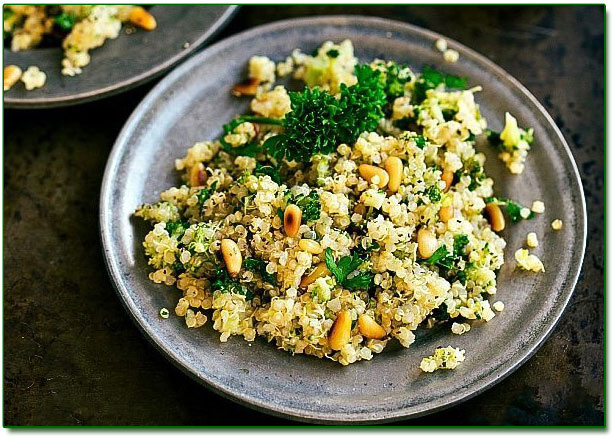
A delicious and easy one-dish broccoli quinoa with toasted cedar nuts. This makes a perfect side dish or a great main course with some added protein.
Ingredients:
- 2 tablespoons cedar nut oil separated
- 1 teaspoon minced garlic
- 1/4 cup yellow onion
- 1 cup quinoa
- 2 cups vegetable broth
- 1 and 1/2 cups broccoli chopped
- 1/4 cup parsley finely chopped
- 1/3 cup cedar nuts
- 1 teaspoon lemon zest
- 3 teaspoons fresh lemon juice
- salt and pepper
Preparation:
In a pot over medium low heat, add 1 tablespoon cedar nut oil, the minced garlic, and the onion. Stir constantly until the onion is tender and garlic is fragrant.
Rinse the quinoa in a fine mesh strainer. (This removes the quinoa's natural coating called saponin which can make it taste bitter.)
Add in the quinoa and vegetable broth. Stir and bring to a boil.
Reduce the heat to low, cover, and turn to low. Allow to cook for about 7 minutes and then stir again.
Spread the finely chopped broccoli (Remove all of the stems and chop into very small pieces like picture shown above.) evenly on top of the cooking quinoa and vegetable broth.
Don't stir in the broccoli but leaving it on top will lightly steam it. Return the cover and cook until the quinoa has absorbed all of the broth and the broccoli has been steamed.
Stir everything together and remove from the heat.
Add in the finely chopped parsley, the fresh lemon zest, the fresh lemon juice, and salt and pepper to taste.
Stir in the cedar nuts. If desired (highly recommended) lightly toast the cedar nuts by placing them in the bottom of the pan you used to cook the quinoa (quickly rinse and dry) over medium heat. No oil is needed. Leave in one layer on the bottom of the pan and stir frequently watching until the cedar nuts become lightly browned. Watch these carefully as they burn easily.
https://www.seriouseats.com/; https://www.foodnetwork.com/; https://www.chelseasmessyapron.com/
CEDAR NUTS CAN BE SUBSTITUTED WITH CEDAR NUT FLAKES.
For more recipes please click here

For Educational purposes only
This information has not been evaluated by the Food and Drug Administration.
This information is not intended to diagnose, treat, cure, or prevent any disease.
These articles come directly from researchers and are passed on to everybody. The company assumes no liability for any content in these articles.
For more great articles go to http://www.ringingcedarsofrussia.org/cedar_nuts_and_ringing_cedars_information.php